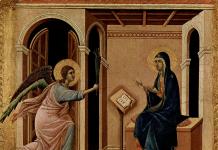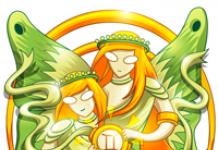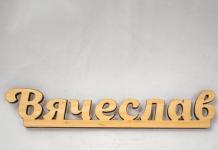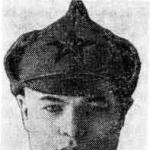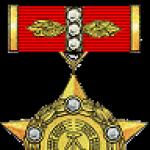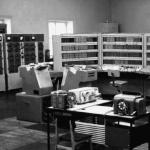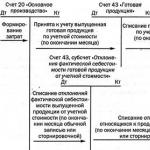Added: 01/17/2012
Queen Anne's Revenge. Model from the North Carolina Maritime Museum
Queen Anne's Revenge
Thanks to the vigorous activity of the film industry, this ship has recently become widely known even in circles far from historians of sea piracy. However, unlike other ships of the pirate epic, Queen Anne's Revenge is a real ship, the flagship of the well-known pirate Edward Teach or Edward Thatch, nicknamed Blackbeard.
To be fair, it must be said that Blackbeard, as a fictional character, became widely known long before Pirates of the Caribbean. Both D. Defoe and Stevenson (the prototype of Flint) wrote about him. This is not to mention the countless myths and legends.
Everyone knows "...fifteen people for a dead man's chest...".
More correctly, “...on Dead Man’s Chest...” - an island in the Caribbean Sea measuring 200 square meters. meters, where, according to legend, Teach landed 15 people from his team, who rebelled against the cruelty and extravagance of the captain. Having provided them only with sabers and rum - a bottle per brother - Blackbeard hoped that the rebels would go crazy from thirst, hunger, heat and kill each other.
The legend says - everyone survived.
By the way, the English “Yo-ho-ho” is not our “O-ho-ho”, but rather “One-two-take”
 Edward Teach, Antique engraving
Edward Teach, Antique engraving
Edward Teach (real name Edward Drummond) was born in England around 1680. During the Anglo-French "Queen Anne's War" (1702-1713) he traded in privateering, and later joined Benjamin Hornigold, who robbed French and Spanish ships in Caribbean Sea.
Queen Anne's Revenge was previously a three-masted French ship, La Concorde, whose crew was actively involved in the slave trade.
In November 1717, a detachment of pirates under the command of Blackbeard on 2 small sloops captured Concord, a well-armed 300-ton ship.
A little later, when Hornigold, in the hope of an amnesty, retired, Blackbeard led the pirates who joined him, making Concorde his flagship and renaming her Queen Anne's Revenge. According to eyewitnesses, it was a ship that had excellent seaworthiness, initially having 26 guns, it was re-armed by Tich and carried up to 40 guns and 150 crew.
By the way, during the expropriation of Concord, the French suffered only “financial and moral losses” - they, along with their slaves, were landed on the nearest shore and, moreover, one of the pirate sloops was allocated to them as compensation.
 Restored cannon. Exhibit at the North Carolina Maritime Museum
Restored cannon. Exhibit at the North Carolina Maritime Museum
1717 and almost all of 1718 were very successful for Blackbeard - his flotilla grew to 4 ships (another famous ship of Edward Teach - "Adventure"), the crew numbered more than 300 pirates. They robbed over 40 ships, undertook coastal raids and naval blockades (the famous blockade of Charlestown in South Carolina). However, by this time, the governors of the Bohamian Islands and especially Virginia were taking a number of measures to combat coastal piracy.
In June 1718 Queen Anne's Revenge ran aground and then sank in Topsail Bay - the area of present Beaufort Inlet. According to one version, Blackbeard tried to hide from his pursuers in secluded places in North Carolina and could not cope with the difficult shipping situation in this water area. According to another, Teach intentionally ran the ship aground, because... After this incident, abandoning his crew, he disappeared with a small group of pirates and all the loot on a small sloop. And he no longer needed Queen Anne's Revenge herself, since she was too noticeable and too famous in these waters.
In the summer and autumn of 1718, Blackbeard undertook a number of pirate forays, but on November 22, English Lieutenant Robert Maynard, hired by the Governor of Virginia, Spotswood, overtook Teach's ship. The pirate leader was killed in hand-to-hand combat.

Exactly 278 years later, on November 22, 1996, a rusted anchor was discovered under water in the Beaufort area, and then the remains of an ancient ship. Subsequent underwater work and laboratory studies of artifacts raised from the bottom allow us to assert with increasing confidence that the found ship was precisely Queen Anne's Revenge - Queen Anne's Revenge(although a huge number of ships and vessels - several hundred! - were wrecked in these waters at various times)
Work on this find continues to this day. Underwater research, laboratory research, work in archives... And as usually happens in such cases, a new discovery gives rise to new questions...
What did he look like? La Concorde - Queen Anne's Revenge?
The answer to this question has not yet been found. However, it is unlikely that his appearance corresponded to the cinematic one. Researchers such as David Moore, an employee of the North Carolina Maritime Museum, prefer an image more consistent with that presented in the monograph by J. Boudriot (J. Boudriot Monographie LE MERCURE - Navire marchand 1730)
If you would like to keep up to date with the latest research developments Queen Anne's Revenge We recommend visiting the site

"Queen Anne's Revenge"
The secrets and treasures of pirate ships buried in the depths of the sea still attract adventurers who are ready to devote their lives to searching for them.
In 1996, an expedition of researchers discovered the claw of the anchor of the ship of the famous pirate of the early 18th century: “Queen Anne's Revenge”, Edward Teach alias Blackbird (“Blackbeard”).
Fate of the ship
More than two and a half centuries ago, the flagship pirate ship Queen Anne's Revenge sank off the coast of North Carolina. Blackbird, the ship's captain, abandoned the ship with his crew in June 1718 when the ship ran aground.
And on November 22, 1996, exactly the anniversary of Blackbird's death, divers from the Intersol research group discovered an anchor claw sticking out of the sand on the seabed off the coast of Beaufort (North Carolina).
They continued their search and found several more guns. Since then, the expedition has returned to this site several times and found hundreds of other items, including cannons, a bell and weapons. In the fall of 1997, researchers managed to discover part of the ship's skeleton.
Much indicates that the expedition found the ship Queen Anne's Revenge.
"Demon of the Seas"All that is known about Blackbird's early life is that he was born in England, probably in the 1790s in Bristol or London.
His real name is Edward Teach, although some sources call him Edward Thatch.
What is certain is that after becoming a pirate, he took the pseudonym Blackbird (“Blackbeard”).
He actually wore a long black beard, with black ribbons woven into it.
As his crew began the boarding, Blackbird calmly smoked and blew wisps of smoke through his beard: creating a demonic image of the “sea devil,” he hoped that the ship captains would surrender to him without a fight.
Probably, like many pirates, he started out as a privateer. In 1713 he settled by the sea and soon joined Ben Hornigold's crew of pirates.
After Hornigold received amnesty and gave up piracy in 1717, Blackbird took command of his flagship, a former French slave ship known as the Concorde.
Blackbird additionally armed it with cannons and renamed it Queen Anne's Revenge.
Together with his crew of three hundred people, he spent the next few years piracy in the Caribbean and off the eastern shores of America, robbing a total of 40 ships.
Blackbird was the most famous pirate to roam the North Carolina coast in the early 18th century.
How ferocious he was can be judged by the legends. So, according to one of them, he forced his captive to eat his own ears, and according to another, he cut off a finger of a prisoner who did not want to give up his ring.
After Blackbird lost the Queen Anne's Revenge, his ships continued to plunder throughout the summer and fall of 1718. It is known that in September of the same year, he and his crew organized a grand feast that attracted many pirates.
This was the last straw for Virginia Colonial Governor Alexander Spotswood, who decided to send two sloops under the command of Royal Navy Lieutenant Robert Maynard to finally deal with Blackbird.
On November 21, Lieutenant Maynard's ships overtook the pirate fleet near Ocracoke Bay, and the battle began the next day. Blackbird was the first to fire a cannon attack, which killed several people from the British ship. But Maynard was a worthy opponent.
He outwitted Blackbird by making him believe that most of the English crew had been killed, while the sailors were safely hidden. When Blackbird began to board the ship, he ran into an ambush. Sources say: a terrible fight ensued between Blackbird and Maynard, during which the lieutenant wounded the pirate with a pistol and pierced him with a sword.
But he did not give up until one of the members of the English team rushed at him with a knife and cut his throat. Maynard cut off Blackbird's head and placed it on the bow of his ship, setting off on his victorious return journey. A well-deserved death has finally found the ferocious “demon of the seas.”
Edward Teach
(c. 1680-1718).
Edward Teach(Edward Teach) - an English pirate who traded in the waters of North America and the West Indies in 1716-1718. Also known by his nickname Blackbeard. He was one of the most odious figures in the history of maritime robbery. He became a hero of American folklore, numerous novels and films. Legends about the treasures he buried still excite the imagination of pirate treasure seekers.
The date and place of birth of this robber have not yet been clarified. Most authors believe that he was born in Bristol around 1680, went to sea at an early age and served on corsair ships during the War of the Spanish Succession (1701-1713). There is also a version that Teach was a native of North Carolina, and the Jamaican chronicler Charles Leslie wrote in 1740 that Blackbeard was born in Jamaica "of very respectable parents" and that his brother was the captain of an artillery train.
If Teach was a corsair during the War of the Spanish Succession, then after its end he could, like many other corsairs, be left without work. Johnson claims that Blackbeard did not engage in piracy until 1716, and we can agree with this. His name appears in documents of the British Admiralty only from 1716. Having settled on the island of New Providence, the main pirate base in the Atlantic, Teach joined the leader of the Bahamian pirates, Benjamin Hornigold, who in December 1716 transferred under his command the sloop he had captured as a prize. In March 1717, Captain Matthew Munson, visiting the Bahamas, learned about the presence of 5 pirate captains on New Providence, including Edward Teach; the latter commanded a 6-gun sloop and about 70 cutthroats.
"The Capture of the Pirate Blackbeard, 1718", artist Jean Leon Jerome Ferris.
On New Providence, Teach and Hornigold met the aspiring pirate Steed Bonnet, whose sloop, the Rivenge, Blackbeard took under his command. In September, they sailed north from the Bahamas to Delaware Bay, where they captured 11 ships, including a ship from Havana with 120 barrels of flour and a sloop from Bermuda skippered by Thurbar, from which they took several gallons of wine. On September 29, 1717, the Rivenge robbed the sloop Betty with a cargo of Madeiran wine.
Later, pirates captured the ships Spofford and Sea Nymphs from Philadelphia, and on October 22, the sloops Robert and Good Intent were robbed, from which the robbers took food. With cold weather approaching, Teach finally turned south and set off from the shores of North America to the Caribbean Sea.
On November 17, the 14-gun French slave ship Concorde (200 tons) from Nantes was attacked 100 miles south of Martinique by two pirate ships. The captain of the Concorde was Pierre Doss. According to the French, one pirate sailing ship had 12 guns and 120 crew, and the second, 40-ton Bermuda sloop, had 8 guns and 30 crew. After a hot battle, the Concorde was captured by Teach's people, who took her to the island of Bequia, renamed her Queen Anne's Revenge (Queen Anne's Revenge) and increased the number of guns on board to 40. Captain Doss was given the Bermuda sloop and almost all black slaves, with whom he arrived safely in Martinique.
On December 5, south of Puerto Rico, Captain Teach boarded the English sloop Margaret, heading from St. Christopher Island under the command of skipper Henry Bostock. Before he was released ashore, Bostock spent eight hours aboard the Queen Ann's River and had the opportunity to closely examine the pirate leader. According to him, "Captain Teich [Teach] was a tall, thin man with a very black beard, which he wore very long."
Shortly before December 19, Teach and Bonnet separated. The latter went towards the Gulf of Honduras, where, apparently, he pirated until the spring of 1718. Meanwhile, Teach, cruising in the area of the island of St. Vincent, captured the large English ship Great Allen. Having cleared its holds, the pirates landed all the prisoners on the shore of St. Vincent, and set the prize itself on fire. Throughout the winter, pirates hunted in the area of the Lesser Antilles and Puerto Rico, but the details of their cruising are unknown.
In March 1718, Blackbeard sailed to the Gulf of Honduras and along the way again met with Steed Bonnet's Revenge. Teach joined him, but a few days later, seeing that Bonnet knew nothing about maritime affairs, with the consent of his people, he appointed his assistant Richards as commander of the Rivenge. He took the major on board his ship.
On one of the islands in the Turneff group, the pirates replenished their fresh water supplies. At this time, the sails of an unknown sloop appeared at sea. Captain Richards immediately weighed anchor and, raising a black flag on the mast, came out to meet him. The stranger surrendered without a fight. It turned out that it was the 80-ton sloop Adventure from Jamaica, under the command of skipper David Herriot. The pirates took the prisoners aboard the Queen Ann's River, and chose Israel Hands, the navigator from Teach's ship, as captain of the prize.
On April 9, the pirates raised sails and headed deep into the Gulf of Honduras, where they robbed several merchant ships. After this, the robbers went to Turquil Island, and then to Grand Cayman, where they captured a turtle catcher's ship. From the Caribbean Sea, the pirate flotilla entered the Gulf of Mexico, rounded the western tip of Cuba and moved north through the Strait of Florida. Having captured 1 brigantine and 2 sloops along the way, the pirates set off for the coast of South Carolina, where they stood near the port of Charleston for five or six days.

Edward Teach, nicknamed Blackbeard, antique engraving.
From Charleston, Blackbeard went to North Carolina and entered Topsail Bay (now Beaufort Bay), where the Queen Ann's River and then the Adventure ran aground. It is believed that Teach and Hands did this deliberately, because they wanted to get rid of extra people and take over most of the loot.
Two crews from the wrecked ships were forced to transfer to a small 8-gun Spanish sloop, and it, overloaded, headed for a small sandy island lying three miles from the mainland. Here, after a quarrel, Blackbeard put 17 sailors ashore, and he himself, with about 40 white people and 60 Africans, went to the port of Bath Town, where he contacted Governor Eden. The latter convened a vice-admiralty court, which recognized the pirate sloop as a legally taken Spanish prize.
In June 1718, Teach again went to sea and headed for Bermuda. Along the way, the pirates met 2 or 3 English ships, but took from them only the provisions and supplies they needed. His men were later seen in Philadelphia, and in August of that year the governor of Pennsylvania issued an order for his arrest.
Teach returned to Bath Town with a shipment of 80 or 90 slaves captured from the French. This living commodity was immediately purchased by the planters. Having refitted the ship, Blackbeard announced that he was setting off on a "trading voyage" to the island of St. Thomas; However, it did not come to trade. Near Bermuda, the pirates came across 2 French ships, one of which was loaded with sugar and cocoa, and the other was empty. Teach released the ship, which had no cargo, transferring all the sailors from the loaded ship onto it; the latter he brought to North Carolina.
Meanwhile, the skippers of the sloops, which were often attacked by Blackbeard, held a meeting with the merchants and some of the planters and decided to put an end to the pirates. Since the governor of North Carolina was in league with Teach, they sent a delegation to neighboring Virginia. The local governor, Alexander Spotswood, agreed that it was time to take more effective measures to eliminate piracy.
The crucial hour came in November 1718, when informants reported that Blackbeard was in Ocracoke Bay and was preparing to fortify the neighboring coast with the goal of turning it into a “second Madagascar.” Spotswood invited Captains Brand and Gordon, who commanded the warships Pearl and Lime (the latter were stationed on the James River), to a meeting. It was agreed that for operations in shallow waters, the governor would hire 2 small sloops, the crews of which would be staffed by sailors from warships and equipped with hand weapons and ammunition. Their command was entrusted to Robert Maynard, the first lieutenant of the Pearl.
On November 17, 1718, Lieutenant Maynard sailed from Kikkwetan, on the river. James in Virginia, and on the evening of the 21st he came to the mouth of Ocracoke Bay, where he saw a pirate sloop.
Seeing Maynard's sloops, Blackbeard prepared his ship for battle. He had 25 people on board, although he told the skippers of all the ships he met that he had 40 people on board.

The head of Edward Teach, nicknamed Blackbeard, at the end of the bowsprit.
The battle that broke out in Ocracoke Bay was stubborn and bloody. “Blackbeard and the lieutenant fired a pistol at each other, which wounded the pirate,” wrote Charles Johnson, “and then fought with sabers until the lieutenant’s saber, unfortunately, broke, so that he was forced to retreat in order to cock the hammer, but at that moment, when Blackbeard struck him with a cutlass, one of Maynard’s men inflicted a terrible wound on him in the neck and throat...
Now they came close and fought tooth and nail - the lieutenant with twelve sailors against Blackbeard with fourteen - until the sea around the ship was stained with blood; Blackbeard was wounded in the body by Lieutenant Maynard's pistol and yet did not retreat and fought with great fury until he received twenty-five wounds, five of them from gunshot. Finally, having already fired several pistols and cocking another, he fell dead; by that time eight more of the fourteen had fallen, and all the rest, very wounded, jumped overboard and asked for mercy ... "
Having defeated the pirates, Lieutenant Maynard ordered Teach's head to be cut off and hung at the end of the bowsprit, after which he sailed to Bath Town to help his wounded sailors.
After the wounded were sufficiently recovered, Maynard sailed back to Virginia, with Blackbeard's head still hanging from the end of the bowsprit, and with 15 prisoners, of whom 13 were hanged. On the pirate sloops and in a tent on the shore of Ocracoke Bay, Maynard's men found 25 barrels of sugar, 11 barrels and 145 bags of cocoa, a barrel of indigo and a bale of cotton. Together with what was seized from Governor Eden and his secretary, and the proceeds from the sale of the sloop, it amounted to £2,500. In addition, the expedition members received bonuses announced by the Governor of Virginia in his proclamation. All money was paid within three months and divided between the Lime and Pearl teams.
According to legend, Teach's head was taken to the capital of Virginia and put on a pillory. Birds feeding on carrion dealt with it within a few days, after which the skull of the famous pirate turned into a hornet's nest.
From the book: V.K. Gubarev "100 great pirates".
Victor Gubarev - victor-gubarev.livejournal.com
In the history of piracy, fiction and truth are mixed and often inseparable. Just look at the description of Teach’s appearance, which has become a textbook in numerous biographies of this robber, as if he embodied all the evil of the pirate world. “The face of Captain Teach... was completely covered with dense vegetation, which immediately attracted the eye. This beard terrified America... It was black in color, and the owner brought it to such monstrous proportions that it seemed as if hair was growing straight from the eyes. Teach used to braid it into small pigtails intertwined with ribbons... and throw them behind his ears. During battle, he hung a wide belt with three pairs of pistols in holsters on each shoulder and stuck fuses under his hat so that they hung down, almost touching his cheeks. His eyes were naturally fierce and wild. It is impossible to imagine a more terrible figure than this demon-possessed man, comparable only to a fury from hell...” This vivid description belongs to the pen of one of the first historians of piracy, a mysterious writer, under the pseudonym Captain Charles Johnson, who created the book “A General History of Robberies and murders committed by the most famous pirates, as well as their customs, customs and government from their very beginning and appearance on Providence Island in 1717 until this year 1724" ("General History of Piracy").


Blackbeard's ship "Queen Anne's Revenge" from the film
"Pirates of the Caribbean: On Stranger Tides."
Artifacts from the pirate ship will reveal the secrets of Blackbeard.
In 2011, archaeologists began an operation to recover from the bottom of the Atlantic the remains of the ship Queen Anne's Revenge, on which the legendary pirate Edward Teach, nicknamed Blackbeard, plied the seas.
A cannon weighing 900 kg, as well as small dishes, jewelry and even shackles, were recovered from a ship that sank 300 years ago off the coast of North Carolina. The recovered artifacts were first put on public display and then sent to a laboratory for analysis.
A one and a half ton anchor was also removed from the bottom. Now scientists face painstaking work to restore the find. After this, the anchor will be exhibited in a local museum; it will add to the collection of exhibits, one way or another connected with the legend of Blackbeard. The wreckage of the ship "Queen Anne's Revenge" was discovered back in 1996, but the anchor was only raised to the surface on May 27, 2011.
Scientists hope that objects found at the bottom will help find out the truth about the British pirate. All archaeological work on the ship is planned to be completed by 2013.
Pirate Edward Teach traded in the Caribbean at the beginning of the 18th century. The heyday of his “activity” occurred in 1716 - 1718.
According to historians, Queen Anne's Revenge originally belonged to French slave owners. Now archaeologists hope that they will be able to lift two more anchors, which were tightly glued to the ship.
The ship Queen Anne's Revenge was no doubt used for naval combat during the captain's bloody quest. Previously, archaeologists managed to recover over 220 thousand lead bullets and grapeshot, as well as 25 cannons, many of which were loaded, from the ship.
Anchor of the ship "Queen Anne's Revenge".
- The ship Queen Anne's Revenge sank in 1718. What is left of him now?
Wild-Ramsing: Of course, over so many years the condition of the ship has deteriorated greatly. The place where the ship sank looks like a field of ruins. Very few wooden objects remain, with the majority being hard, rigid objects made from iron, ceramics and stone. But because the iron spent so much time in salt water, a crust formed, which we call "splice." Objects lying next to the metal grew to it. Thus we found parts of sails, ropes, copper tools, pewter dishes, small pieces of gold and animal bones (pigs, cows that the pirates ate).
- What other pirate things did you get from the bottom of the ocean?
Wild-Ramsing: The anchor was the main find, and it was for this that we started the expedition. Before this, we managed to get some small objects: lead bullets for firearms, cannonballs. We encountered sticky lumps of lead shot, nails and sand. We believe that this mixture was placed in canvas bags into cannons and these were homemade shells. It was possible to find metal items of the officers' clothing, medical instruments, a wooden part of the stern of the ship, boards, frames, gold powder, wine bottles and crystal glasses and many other small things.
-Have you already decided which artifact you will get from the bottom next?
Wild-Ramsing: We don't know... and that's the most exciting part of our job. We will explore the front of the ship, where the pirate crew lived and worked, and of course the galley. Who knows what we might find there.
- Where are all the found artifacts stored?
Wild-Rumsing: An exhibition of all the artifacts and descriptions of our research just opened at the North Carolina Maritime Museum in the North Carolina Bay.
- The owner of the ship "Queen Anne's Revenge" was the famous pirate Blackbeard. What new things have you learned about this hero?
Wild-Ramsing: Our preliminary reports largely agree with historical facts. Blackbeard was the captain on the ship "Queen Anne's Revenge", before the ship sank, he hastily took most of his personal belongings, but some still remained (researchers call the hilt of his sword the most valuable of Blackbeard's surviving things). There are also some discrepancies with history. For example, according to our version, the anchor was used to prevent the ship from running aground. But according to the official version, the captain himself ran the ship aground. Of course, we will not be able to find out the whole truth, but new assumptions and clues to the correct answers will appear.
- Is it possible to reconstruct the history of piracy in the Caribbean region based on these finds?
Wild-Ramsing: We are just beginning to get an idea of what the life of a pirate was like in the 18th century, we are beginning to learn more about the lifestyle of sea robbers: what they ate, what games with drinking were popular among the robbers, what dishonest tricks they used, when they wanted to cheat. But perhaps the crown jewel of the collection are the weapons and ammunition, such as a Swedish pistol made in 1712, which was loaded with bullets and bolts, showing the ingenuity of the pirates. During collisions with other ships, they sought to frighten the crew and disarm them. They tried to take the sailors by surprise, and not to sink the ship, as happened in traditional naval battles. In addition, no one supplied them with ammunition, so they had to make do with handy means, such as bolts.
- For most people, your research is especially interesting due to the popularity of the film "Pirates of the Caribbean". Did the film influence your work and investors' interest in the project?
Wild-Ramsing: Since the film's release, many have been fascinated by pirates. Therefore, when we make another discovery, there is great interest from all over the world. And now even from Russia! After the release of the last episode, attention became more intense because the character Blackbeard and the ship “Queen Anne's Revenge” appeared in the film. And we like to think that our search inspired Hollywood producers to include them in the film. Of course, we appreciate the promotion we got from so many people watching Pirates. This helped finance the project. In the 18th century, pirates were people who played an important role in the development of the New World.
Edward Teach (real name Edward Drummond), nicknamed Blackbeard, was a terror in the Caribbean. In his fourth decade of life, he became famous for his successful attacks and robbery of merchant ships encountered on his way. In 1716, he joined Benjamin Ornigold's pirate crew operating in New Providence Bay. Soon Blackbeard himself became a captain, having received Queen Anne's Revenge at his disposal.
In 1717, the authorities of the Bahamas announced a merciless fight against piracy, and the governor of Virginia announced a reward for the capture or murder of Teach and his crew. English Lieutenant Robert Maynard took up the hunt for Blackbeard. By 1718, Teach's "squadron" consisted of several sloops and 300 "gentlemen of fortune." In November 1718, Captain Blackbeard, so nicknamed for his thick beard, died during a boarding battle with Maynard's soldiers, who personally cut off Teach's head and ordered it to be hung on the ship's yardarm. Subsequently, Edward Teach, with the help of historians and romanticized legends, became one of the most famous pirates. Thus, images of Blackbeard can be seen in many works about pirates, for example, the character of the same name in the film “Pirates of the Caribbean: On Stranger Tides” and in the famous novel “Treasure Island” by Robert Louis Stevenson.
May 28, 2011
Sources: rg.ru, vsekommentarii.com, utro.ru

Edward Teach, nicknamed Blackbeard.
Photo from the movie "Pirates of the Caribbean: On Stranger Tides."
Medical instruments were found on Blackbeard's ship.
During the research of the ship Queen Anne's Revenge, which belonged to the famous pirate Edward Teach, known as Blackbeard, medical instruments were found. Archaeologist Linda Carnes-McNaughton spoke about this in a report to the Society for Historical Archaeology.
Blackbeard's vessel, which ran aground off the coast of North Carolina and was abandoned by its crew, was discovered in 1996. Since then, underwater archaeologists have been working to study it. In addition to guns, weapons and other items, they found many medical instruments. Among the finds are scissors and silver needles, a pestle and mortar for preparing medicine, vessels, two enemas, and a device for bloodletting. Clamps equipped with screws may have been part of a device for securing the limb during amputation. A metal syringe was also found, which was used in the only method of treating syphilis at that time - pumping a mercury compound into the urethra.
It is known from written sources that Edward Teach, having captured the French slave ship Concorde and turned it into his flagship Queen Anne's Revenge, released the entire crew, but left three ship surgeons who were to treat the wounds and illnesses of Teach's crew.
Linda Carnes-McNaughton discovered lists of Concorde crew members and determined that the doctors' names were Jean Dubois, Marc Bourneuf La Rochelle and Claude Deshaillers. Shortly thereafter, Queen Anne's Revenge and three other pirate ships blockaded the port of Charleston in South Carolina. Edward Teach captured hostages from nine passing ships and informed the governor that if he did not receive a ransom, he would burn the captured ships, execute the hostages and send their heads to the governor. The ransom that Teach eventually received included not only money, but also a large amount of medicine. So the famous pirate managed not only to get professional doctors for the crew, but also to supply them with the necessary medicines.
121. Triangle (3)
Everyone knows about the Bermuda Triangle. From time to time someone disappears there. Mulder believes that the reason for this phenomenon lies in the narrowing of time bands. Thus, disappeared objects move not in space, but in time. The Lone Gunmen seems to be on board with this idea as well. They monitor this region through Google Map (if such a resource already existed in 1998). And now, in real time, they see that the satellite has detected the Queen Anne ocean liner, which went missing in 1939, in the Triangle. They send the coordinates to Mulder, who voluntarily leaves work, flies to Florida, hires a boat there and rushes to the place where the Queen Anne appears. The Lone Gunmen monitor the boat via satellite. But then a storm broke out... and Mulder disappeared from communication.
Further, the action develops in two parallel realities. Mulder was pulled out of the wrecked boat by the Queen Anne's sailors. He is happy: not because he was rescued from the depths of the sea, but because he saw guests from the past. However, as it turned out, it was he - a guest from the future. Everywhere - September 1939, and all the radio stations are talking about the recently broken out war, which does not yet promise to become a world war: the Russians, in collusion with Hitler, are fighting off Poland among themselves, and the rest of the countries are silently watching. But hatred of the Nazis had already formed among ordinary people. “Why do they hate us Germans so much? - the fascists are perplexed, landing on board the Queen Anne (Russian tourists are now increasingly asking this question) - we’re not at war with Great Britain, are we?
But the Germans are here on business: they are looking for Professor Thor Hammer, who can invent an atomic bomb. And the fascists are kind of strange: the Chief Navigator-Führer is the spitting image of the Smoker, his deputy looks like Skinner, and the Smoker’s lackey looks like an FBI agent, his son. But Mulder meets Scully among the passengers. She is on a secret mission to protect the professor.
While Mulder is trying to persuade the crew to go to America so that history continues to take its course and the Germans do not get an egghead who would make a bomb for them, the real Scully, in 1998, is trying to find the coordinates of the crash of Mulder's boat and the Queen Anne that suddenly appeared. After much worry, she gets it - Skinner helps her.
Scully and the Lone Gunmen get there, and indeed, they see an ocean liner. The lights are on, but people's voices are not heard. They board the Queen Anne. This is a ghost ship: everything is new, but no one is alive. All life is in a parallel reality. There, in 1939, the crew escaped from a closed hold and attacked a detachment of Nazis. The passengers provided the sailors with warm and effective support. While everyone was fighting in the restaurant, Mulder and a passenger who looked like Scully were running around the decks, and the SS men were chasing them. One almost caught up, but a German who looked like Skinner, who turned out to be a spy, shot him. Eventually, Mulder decides to get off the Queen Anne and jumps overboard. Before the jump, he kisses the passenger and gets punched in the face by her.
Time connects again. Fox, unconscious, is dragged aboard the Lone Gunmen. Mulder comes to his senses in 1998 and begins to talk about his adventures. And he confesses his love for Scully. Fox is destined to be considered a nutcase: he was considered a nutcase in 1939, and in modern times too. Scully didn't even respond to the confession of love and left. But Mulder's cheek, where it was slapped, still ache pleasantly.
Adventure Galley is the favorite ship of William Kidd, an English privateer and pirate. This unusual frigate galley was equipped with straight sails and oars, which made it possible to maneuver both against the wind and in calm weather. The 287-ton ship with 34 guns accommodated 160 crew and was primarily intended to destroy the ships of other pirates.

Queen Anne's Revenge is the flagship of the legendary captain Edward Teach, nicknamed Blackbeard. This 40-gun frigate was originally called Concorde, belonged to Spain, then passed to France, until it was finally captured by Blackbeard Under his leadership, the ship was strengthened and renamed. "Queen Anne's Revenge" sank dozens of merchant and military ships that stood in the way of the famous pirate.

Whydah is the flagship of Black Sam Bellamy, one of the pirates of the golden age of sea robbery. The Ouida was a fast and maneuverable vessel capable of carrying a lot of treasure. Unfortunately for Black Sam, only a year after the start of his pirate “career” the ship was caught in a terrible storm and was thrown ashore. The entire crew, except two people, died. By the way, Sam Bellamy was the richest pirate in history, according to Forbes' recalculation, his fortune amounted to about 132 million dollars in modern equivalent.

"Royal Fortune" belonged to Bartholomew Roberts, the famous Welsh corsair, with whose death the golden age of piracy ended. Bartholomew had several ships during his career, but the 42-gun, three-masted ship of the line was his favorite. On it he met his death in battle with the British warship "Swallow" in 1722.

Fancy is the ship of Henry Avery, also known as Long Ben and the Arch-Pirate. The Spanish 30-gun frigate Charles II successfully plundered French ships, but eventually a mutiny broke out on it, and power passed to Avery, who served as first mate. Avery renamed the ship Imagination and sailed on it until his career ended.

Happy Delivery is a small but beloved ship of George Lowther, an 18th-century English pirate. His signature tactic was to ram an enemy ship with his own while simultaneously boarding it with lightning speed.

The Golden Hind was an English galleon that, under the command of Sir Francis Drake, circumnavigated the world between 1577 and 1580. The ship was originally named "Pelican", but upon entering the Pacific Ocean, Drake renamed it in honor of his patron, Lord Chancellor Christopher Hatton, who had a golden hind on his coat of arms.

The Rising Sun was a ship owned by Christopher Moody, a truly ruthless thug who took no prisoners as a matter of principle. This 35-gun frigate terrified Moody's enemies until he was safely hanged - but she went down in history with the most unusual pirate flag known, yellow on a red background, and even with a winged hourglass to the left of the skull.
Large and tiny, powerful and maneuverable - all these ships, as a rule, were built for completely different purposes, but sooner or later they ended up in the hands of corsairs. Some ended their “careers” in battle, others were resold, others sank in storms, but all of them glorified their owners in one way or another.
